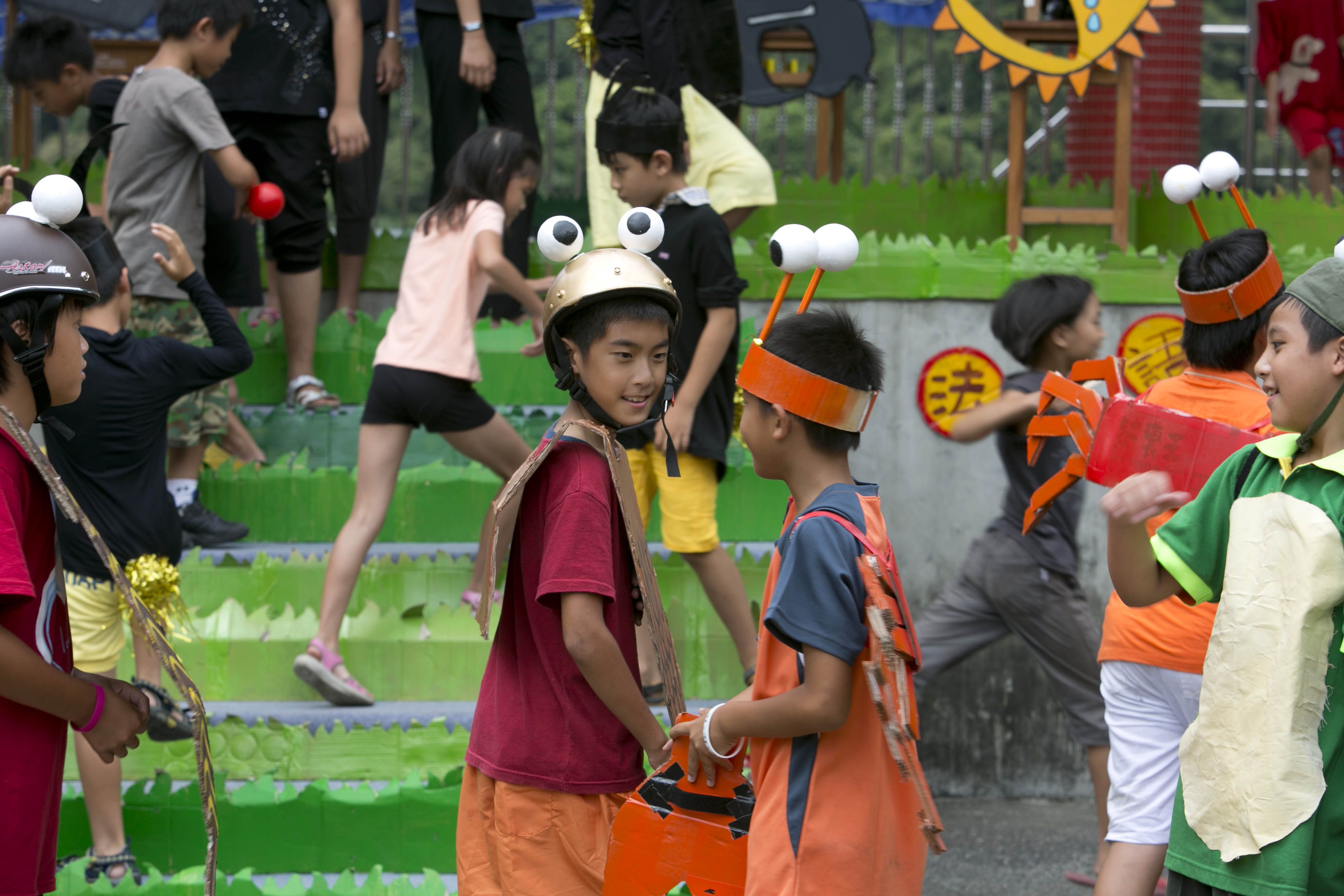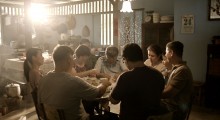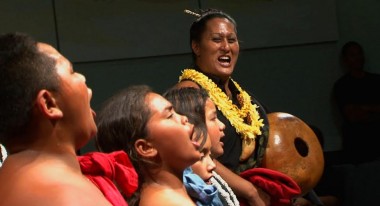 Back to selection
Back to selection
Transformers: The Asian American International Film Festival
 A Time in Quchi
A Time in Quchi Over the years, many New York-based media arts organizations and the film festivals they produce have folded, or scraped by in spite of outdated approaches and rigid programming. Asian CineVision and its offspring, the Asian American International Film Festival, on the other hand, have proven to be the little engines that could. The secret to their success: a keen awareness of shifts in the zeitgeist and talent pool, without losing sight of the Asian American community they serve (with a value added outreach to non Asian American communities). They are masters of reinvention.
The 37th edition of the AAIFF (July 24-August 2) is comprised of 18 features and 33 shorts whose point of origin and makers might be Asian American or Asian (with an occasional non-Asian or non-Asian American directing an Asian subject). It’s a far cry from the first year, a modest three-day affair back in 1978 at the Lower East Side’s Henry Street Settlement that many considered a one-off. That virgin event was an attempt to showcase films by Asian American independents, hardly high at the time on distributors’ acquisition lists.
Former Executive Director Peter Chow, a legendary charismatic force, had founded what would become known as ACV three years earlier under the moniker CCTV (Chinese Cable TV) with Danny Yung, Thomas Tam, Christine Choy, and Tsui Hark (then studying in New York). The intention was to provide workshops to train the Chinatown community in video techniques so it could produce half-hour Chinese-language programs for Manhattan Cable’s new access channel to promote change in areas such as housing and health care. The task proved too taxing for the small group, but other non-profits rose to the occasion and took over. In the vacuum, Chow started programs in exhibition, distribution and information services.
That first fest was a logical next step. Since then, it’s been a collective effort. Committees and guest curators have done the programming. As political as arts events can be, heady and impassioned debates about inclusion come with the territory. Many of the early films were issue-oriented, but some selectors argued successfully for the screening of more personal, self-focused and non-narrative works as well.
Emerging crises demanded responses that had to be thought-out rather than reacted to in knee-jerk fashion. More and more Asian American films were finding distribution here and no longer required the festival as a showcase — though not before the AAIFF had introduced the public to the works of such then-unknown directors as Ang Lee, Mira Nair, and Wayne Wang. To fill in the gaps, the committees began inviting films from Asia —as it turned out, a wise decision. A glance at the list of titles from the first years to the present indicates a steadily increasing proportion of films from abroad in the line-up. And an ideological plus: the incorporation validates the ties between Asia and the Asian diaspora. Fortunately for the AAIFF, encompassing films from Asia began at a time when production on much of the continent was on a roll, wave following wave, festival darling succeeding festival darling.
This chameleon of an event not only retains its eclectic nature, it builds upon it as needed. For example, directors of films about Asian or Asian American subjects need not be of Asian extraction. In this city, titles in some major festivals can be too predictable. This is not the case in this refreshing mélange. Most of this year’s features, Asian American and Asian, lack distribution, so AAIFF still serves a practical function for films that might otherwise be overlooked. A focus on important, relevant issues remains a priority. The commitment to more intimate, sometimes vanguard work still holds.
Lesley Qin, a Shanghai-born member of the current selection committee and ACV’s high-energy program manager, enthusiastically elaborates upon what might have been a contradiction if resilience and openness were not so much a part of the organizational mindset: the zestful embrace of such disparate forms, themes, and genres, even the filmmakers themselves, yet with an important constant, a guiding principle that has remained in place through 37 editions:
With the political DNA of the festival, we get excited when we find films that speak to the most immediate issues, from farming activism in Taiwan to the deportation of Filipino children in Tel Aviv. But we are also curiously drawn to the quieter and anonymous spaces, those that can not be summarized by a log-line but will make you fly high into your imagination and dive deep into your emotions, whether it be a Japanese love hotel, a Hawaiian hula performance, or the mysterious wasteland in Raya Martin’s experimental film.
The common denominators are that all are honest, intimate expressions from their creators, and that they align with the inherent query of an ethnic festival, where identity politics — why are you making this film, and who are you making it for? — are still indispensable.
Sad to say in light of the AAIFF’s original mandate, features by Asian American directors are among the weakest in this year’s selection. I’m not sure how many others may have crossed over and do not want to be placed in a niche, but those that are in the lineup are mostly light fare like a fashionista rom-com and a few instantly forgettable thin comedies. Thankfully, the balance of quality has altered significantly over time. Metamorphosis and diversity are the festival’s salvation.
Without a doubt, the three strongest films are Asian. If you have time for only one screening, make it the sublime A Time in Quchi, by Taiwanese filmmaker Chang Tso-chi. A gorgeously photographed, moving, and leisurely paced melodrama with a healthy melancholic streak, it tracks the budding rapport between a sullen 10-year-old fixated on his electronic gadgets and his equally sour, cranky octogenarian grandfather, a controlling and proudly independent recent widower of the old school deeply attached to the memory of his beloved wife (he paints her face on stones). Bao’s wealthy, ambitious parents yank him from his comfy urban life in Taipei and dump him for the summer on Grandpa in the nearby countryside so that they can have some space to carry out a nasty divorce. They have spoiled but neglected him, showering him with all manner of playthings without noticing the gaping holes in his sneakers.
In this atypical coming-of-age tale, the introverted, self-centered boy is forced to adjust to a country school. In a brilliant stroke, Chang structures the film as a series of 20 homework assignments from his city school that document his summer vacation, many of them in voice-over. (The Chinese title translates as Summer Holiday Homework.) In his early entries, he feels compelled to lie, to write what the teacher would want to read. He is miserable and so keeps to himself that he really has nothing to write about.
Montages that we accept on faith let us know that Bao has emerged from his shell. The loner becomes a team player. He plays basketball, bicycles, and perform in a comically ridiculous French school play with fellow students, among them aboriginals and kids from poverty, children he would never have been exposed to in his affluent Taipei neighborhood. We share his newly developed curiosity when he becomes entranced by such natural phenomena as praying mantises and glorious tree formations.
Then real life hits him over the head, in the form of a tragedy that enables him not only to empathize with his grieving grandfather, but to write sincerely, honestly — from the deepest wells of his heart, as he puts it. We witness his appropriation but inventive revision of grandpa’s symbolic commemoration of gut-wrenching loss. While never taking Bao, his high-octane younger sister, his dear new-found friends, and his charismatic grandfather out of the foreground, Chang steadily reveals the laughably absurd foibles of the other adults, as if warning, with a dose of humor, of the potential hazards lying ahead for the newly awakened young protagonist.
Room for the experimental remains, and Filipino director Raya Martin’s How To Disappear Completely is an excellent testament to the AAIFF’s decision to include such fare. No conventional melodrama here: this dystopian film is mostly non-narrative, deploying shock effects in an essay on dissolution, disintegration, the breakdown of self and just about everything else. A young woman wants nothing more than to excise her family, in more ways than one. In fact, she wants to destroy just about everything that society values. After a hilariously insipid school play touting patriotism and familial responsibility, the cast vanishes into thin air, only to reemerge for a spree of unharnessed violence.
The gifted filmmaker plays with the materiality of film, using film negative and coloring it in. An aficionado of horror film, especially the work of John Carpenter, Martin creates sequences with the texture and acting style of old horror movies. An unabashed provocateur, he brackets the film with scenes of death: at the beginning mild shots of the girl lying atop a sarcophagus, and at the end a gang destroying the above-ground tombs in the same cemetery, smashing crosses over their covers and molesting frightened young women in the in-between spaces. Ellipsis complete. By the way, for his next project the prolific Martin is planning…a comedy.
Maybe a microcosm of the festival in its variety, Letters From the South is a portmanteau comprised of six short films of varying styles by different directors: Royston Tan, Midi Zhao, Sun Koh, Tsai Ming-liang, Tan Chui Mui, and Aditya Assarat. They are all part of the Chinese diaspora from four countries, Malaysia, Thailand, Singapore, and Myanmar. The common thread is that, theoretically at least, each work is a cri de coeur from “the South” addressed to “the North,” the mother nation of China. In truth, the term letters is used too loosely. In the most successful episodes, displacement is the structuring absence.

By far the finest, and certainly the most affective, is Tan’s Singapore-set segment, Popiah. In many ways it echoes the principal relationship in A Time in Quchi. A handsome, self-absorbed teen spends all his time on his iPhone, even when his extended family comes over for a big dinner to accompany a ritual in which the boy’s traditional dad summons his own late father’s spirit with the help of his lovingly home-made popiah, a pastry-like dish.
Some of the father’s siblings just do not understand why he refuses to buy the pre-made packaged version, but close-ups of his chopping and cooking reveal the devotion inherent in the process. During the ceremony, something touches the son, who up until then has just been oblivious. Overwhelmed, he sheds tears. He is struck by the beauty of this ancient form of communication and all the love and respect that it signifies; he won’t get these on his phone. For the first time, he gets the concept of kinship. The delicious cinematography only adds to the impact.
In Burmese filmmaker Midi Zhao’s Burial Clothes, a young woman returns to Myanmar with her grandfather’s traditional burial outfit. They have rotted, surely a metaphor for the downside of relocation. Of course the clothing is now useless, so the remaining family members burn them. Tsai Ming-Liang’s haunting Walking on Water is the most personal of the six. Dressed in bright red monk’s robes, his longtime muse Lee Kang-sheng walks in extremely slow-motion around the sterile apartment block in Kuching, Malaysia, where the filmmaker lived in his youth, long before he moved to Taiwan.
Then there are docs on the important topics of the day. Using oral histories, debates, and concrete details, Shanghai-born Asian American director Christine Choy’s Ghina tackles the surprisingly large Chinese population of Ghana in an exhaustive political, economic, social, and anthropological overview. The Peoples’ Republic of China bonded with post-colonial African nations in a theoretical show of support, but for the most part the Chinese have been attracted to the continent’s abundant minerals and natural gas, which they have exploited to the point that many Africans consider their presence a form of neocolonialism.
To Choy’s credit, all of the discussions are among Chinese and Africans. Some of the best scenes involve discourse between Ghanian intellectuals who have lived abroad and have a keen understanding of the ways in which their homeland has been manipulated. She makes a significant point: The Chinese have not lived under multiculturalism, so they are incapable of living with the Ghanians as equals. Earthier types participate as well: a Chinese restaurateur, for example, is blatant, if not consciously nasty, in her racism, blathering on about the laziness of the locals while, reminiscent of slave days, praising their loyalty. The hustling Chinese business people regard the Ghanians as machines to take orders; few occupy management positions.
One stunning eye-opener does not fit the usual fest slots: Kumu Hina, an intimate, very personal doc — a filmic encounter, really — by non-Asian American co-directors Dean Hamer and Joe Wilson (Out in the Silence). The two spent a year following a transgendered woman, a mahu, someone who lies between male and female. In the context of this festival, she could, as a Hawaiian, be considered either Asian American or Polynesian, or both, because she is indigenous and closely identifies with her native culture.
Isn’t it ironic? A culturally specific subject plays a culturally pliant festival. The fact that the AAIFF begins on exactly the same day as Newfest this year (on a Thursday at that) makes it especially curious that Kumu Hina is screening at the Asian American rather than the LGBT fest. “Hina transcends the usual categories that western culture seems compelled to put people in,” says Hamer. “Some film festivals get that, like Frameline (where it won the Jury Prize for documentary). Others don’t, like Outfest and Newfest, which decided not to program the film, apparently because they had ‘too many trans docs’ this year — as if every film, too, had to be put in its own little box.”

Unlike what up until recently has been the fate of many transgendered individuals on the mainland, Hinaleimoana Wong-Kalu, or Hina, lives in a supportive native Hawaiian culture that has traditionally held a respectful place for those whose sexual identities are outside the norm. (Jared Greenleaf’s powerful animation illustrates the pre-contact embrace of mahu.) She is a strong woman, the recent bride of a Tongan husband, and a successful teacher of arts, particularly dance, whose self-appointed mission is to promote native culture. She takes under her wing at Halau Lokali, a charter school geared toward all things native, Ho’onani, a young sixth-grade girl with strong ku, or energy, which puts the self-assured youngster in the middle, as they say in Hawaii, and enables her, with Hina’s blessing, to lead the boys-only hula class. (Hamer and Wilson’s next project is a short educational film on Ho’onani, told from her pov, with the goal of showing it in schools all across the country.) The world Hina lives in, and by this I mean class as well as gender, is something that tourists never see. Here’s your chance — and a colorful world it is.
